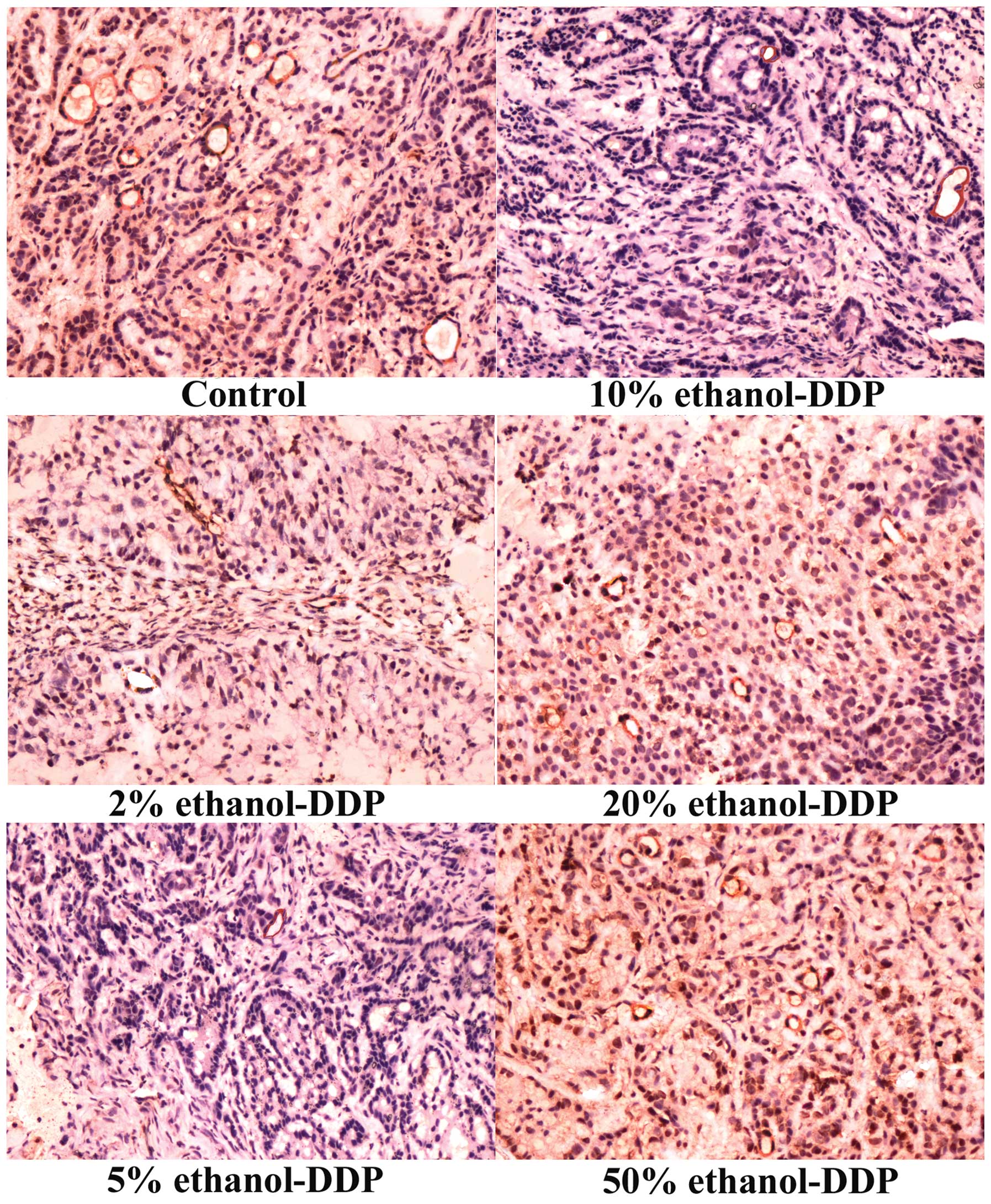|
1
|
Jemal A, Bray F, Center MM, et al: Global
cancer statistics. CA Cancer J Clin. 61:69–90. 2011. View Article : Google Scholar
|
|
2
|
Rossi A, Di Maio M, Chiodini P, et al:
Carboplatin- or cisplatin-based chemotherapy in first-line
treatment of small-cell lung cancer: the COCIS meta-analysis of
individual patient data. J Clin Oncol. 30:1692–1698. 2012.
View Article : Google Scholar : PubMed/NCBI
|
|
3
|
Ardizzoni A, Boni L, Tiseo M, et al; CISCA
(CISplatin versus CArboplatin) Meta-analysis Group. Cisplatin-
versus carboplatin-based chemotherapy in first-line treatment of
advanced non-small-cell lung cancer: an individual patient data
meta-analysis. J Natl Cancer Inst. 99:847–857. 2007. View Article : Google Scholar : PubMed/NCBI
|
|
4
|
Eramo A, Haas TL and De Maria R: Lung
cancer stem cells: tools and targets to fight lung cancer.
Oncogene. 29:4625–4635. 2010. View Article : Google Scholar : PubMed/NCBI
|
|
5
|
Niu Q, Wang W, Li Y, Ruden DM, Wang F, Li
Y, Wang F, Song J and Zheng K: Low molecular weight heparin ablates
lung cancer cisplatin-resistance by inducing proteasome-mediated
ABCG2 protein degradation. PLoS One. 7:e410352012. View Article : Google Scholar : PubMed/NCBI
|
|
6
|
Dean M, Fojo T and Bates S: Tumour stem
cells and drug resistance. Nat Rev Cancer. 5:275–284. 2005.
View Article : Google Scholar
|
|
7
|
Singh A, Wu H, Zhang P, Happel C, Ma J and
Biswal S: Expression of ABCG2 (BCRP) is regulated by Nrf2 in cancer
cells that confers side population and chemoresistance phenotype.
Mol Cancer Ther. 9:2365–2376. 2010. View Article : Google Scholar : PubMed/NCBI
|
|
8
|
Zhang M, Mathur A, Zhang Y, et al:
Mithramycin represses basal and cigarette smoke-induced expression
of ABCG2 and inhibits stem cell signaling in lung and esophageal
cancer cells. Cancer Res. 72:4178–4192. 2012. View Article : Google Scholar : PubMed/NCBI
|
|
9
|
Kim ES, Lee JJ, He G, Chow CW, Fujimoto J,
Kalhor N, Swisher SG, Wistuba II, Stewart DJ and Siddik ZH: Tissue
platinum concentration and tumor response in non-small-cell lung
cancer. J Clin Oncol. 30:3345–3352. 2012. View Article : Google Scholar : PubMed/NCBI
|
|
10
|
Tang CH, Parham C, Shocron E, McMahon G
and Patel N: Picoplatin overcomes resistance to cell toxicity in
small-cell lung cancer cells previously treated with cisplatin and
carboplatin. Cancer Chemother Pharmacol. 67:1389–1400. 2011.
View Article : Google Scholar : PubMed/NCBI
|
|
11
|
Livraghi T, Festi D, Monti F, Salmi A and
Vettori C: US-guided percutaneous alcohol injection of small
hepatic and abdominal tumors. Radiology. 161:309–312. 1986.
View Article : Google Scholar : PubMed/NCBI
|
|
12
|
Kuang M, Lu MD, Xie XY, Xu HX, Xu ZF, Liu
GJ, Yin XY, Huang JF and Lencioni R: Ethanol ablation of
hepatocellular carcinoma up to 5.0 cm by using a multipronged
injection needle with high-dose strategy. Radiology. 253:552–561.
2009. View Article : Google Scholar : PubMed/NCBI
|
|
13
|
Tan W, Bailey AP, Shparago M, Busby B,
Covington J, Johnson JW, Young E and Gu JW: Chronic alcohol
consumption stimulates VEGF expression, tumor angiogenesis and
progression of melanoma in mice. Cancer Biol Ther. 6:1211–1217.
2007.PubMed/NCBI
|
|
14
|
Forsyth CB, Tang Y, Shaikh M, Zhang L and
Keshavarzian A: Alcohol stimulates activation of Snail, epidermal
growth factor receptor signaling, and biomarkers of
epithelial-mesenchymal transition in colon and breast cancer cells.
Alcohol Clin Exp Res. 34:19–31. 2010. View Article : Google Scholar
|
|
15
|
Niu Q, Wang W, Li Y, Ruden DM, Li Q and
Wang F: Cisplatin in 5% ethanol eradicates cisplatin-resistant lung
tumor by killing lung cancer side population (SP) cells and non-SP
cells. Front Genet. 4:1632013.
|
|
16
|
Hamstra DA, Moffat BA, Hall DE, Young JM,
Desmond TJ, Carter J, Pietronigro D, Frey KA, Rehemtulla A and Ross
BD: Intratumoral injection of BCNU in ethanol (DTI-015) results in
enhanced delivery to tumor - a pharmacokinetic study. J Neurooncol.
73:225–238. 2005. View Article : Google Scholar : PubMed/NCBI
|
|
17
|
Weidner N: Current pathologic methods for
measuring intratumoral microvessel density within breast carcinoma
and other solid tumors. Breast Cancer Res Treat. 36:169–180. 1995.
View Article : Google Scholar : PubMed/NCBI
|
|
18
|
Pietronigro D, Drnovsky F, Cravioto H and
Ransohoff J: DTI-015 produces cures in T9 gliosarcoma. Neoplasia.
5:17–22. 2003. View Article : Google Scholar : PubMed/NCBI
|
|
19
|
Jenkinson MD, Smith TS, Haylock B, Husband
D, Shenoy A, Vinjamuri S, Walker C, Pietronigro D and Warnke PC:
Phase II trial of intratumoral BCNU injection and radiotherapy on
untreated adult malignant glioma. J Neurooncol. 99:103–113. 2010.
View Article : Google Scholar : PubMed/NCBI
|











